Featured image: Our amazing group in front of Lawudo Gompa: including the director, Rinpoche’s brother Sangay-la, centre, with Ven Robina and Rinpoche’s sister Ani Samten-la, who’s taken care of the place for nearly fifty years; all the kind staff; and our guides and porters who also pitched in throughout the retreat.
Our first Lawudo Trek, April 5–April 19, 2017, was a huge success. I would have been delighted with twenty trekkers, but a month after opening it for registration, thirty-two people had signed up….
Ven Robina said, “I’ve wanted to go to Lawudo for forty years and I figured there’s no time to waste, it’s now or never!”
More than 4,200 metres above sea level, Lawudo Gompa is the site of the cave where the previous Lawudo Lama, of whom Rinpoche is the reincarnation, had spent the last years of his life in meditation. After hearing about this amazing place during a slide show of Ven Tenzin Namdrol at Kopan Monastery in 2013, I decided I wanted to organise a trek there, to raise awareness and bring in some funds.
I’ve wanted to go to Lawudo for forty years and
I figured there’s no time to waste, it’s now or never!
— Ven Robina
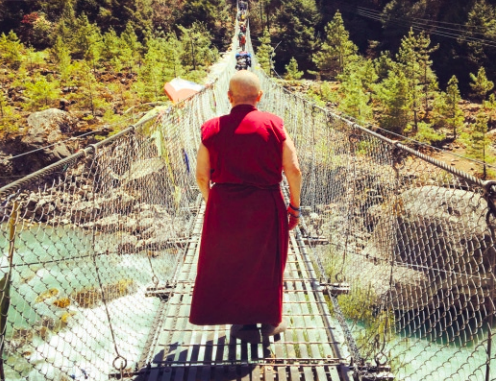
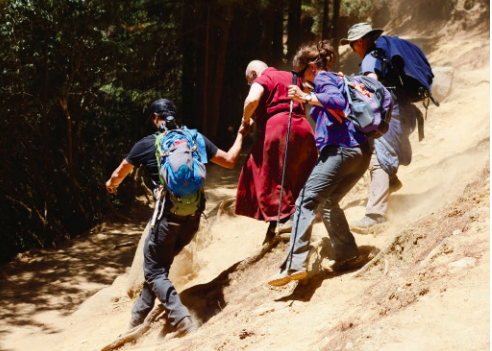
More than 4,200 metres above sea level, Lawudo Gompa is the site of the cave where the previous Lawudo Lama, of whom Rinpoche is the reincarnation, had spent the last years of his life in meditation. After hearing about this amazing place during a slide show of Ven Tenzin Namdrol at Kopan Monastery in 2013, I decided I wanted to organise a trek there, to raise awareness and bring in some funds. I started working seriously on organising last year, and in August I mentioned the idea to Ven Robina Courtin during her visit to Rinpoche’s centre in Sydney, Vajrayana Institute. She insisted that we needed a monk or a nun to teach and lead meditations, making it like a pilgrimage. “I had no thought of doing it myself”, Ven Robina said, “but somehow, by the end of our talk, Kristina had invited me and I’d said yes. I’ve wanted to go to Lawudo for forty years and I figured there’s no time to waste, it’s now or never!” From this moment, the momentum grew. We worked closely with Amber Tamang, a local guide, who has worked with her and Dharma Journey’s Effie Fletcher in San Francisco, who since 2001 has organised pilgrimages to the holy places of India and Nepal as fundraisers for Liberation Prison Project. “I must say I was worried about it. I’d never walked up any kind of mountain in my entire life!” Ven Robina said. “But I felt better in December at Kopan when I mentioned it to Rinpoche, who was so pleased. ‘You’ll never want to come back!’ Rinpoche laughed. Rinpoche offered us malas; everyone got one, including our guides and porters”
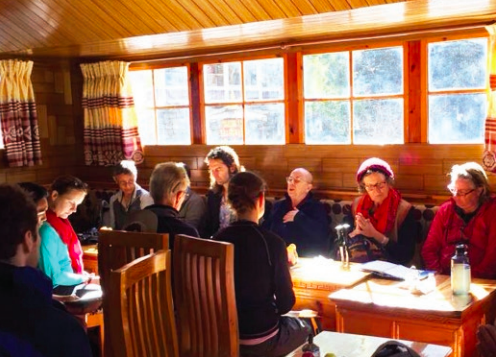
It felt like the mountains were hugging us
with their spiritual energy
— Kim
Our first stop on April 5 was Kopan, Rinpoche’s monastery in the Kathmandu valley. After a couple of days of settling in, and some teachings, we headed to the airport for our plane to Lukla, our starting point for the trek. We missed our morning-scheduled flight –not a good start! The chaos of the busy airport and the unnerving wait, coupled with excitement and impatience to start walking, had us worrying about whether we would even make it to Lawudo. We left several hours late and finally made it to Tenzin-Hillary Airport. After an energising lunch at Himalaya Lodge, we got started. It’d be an easy walk,
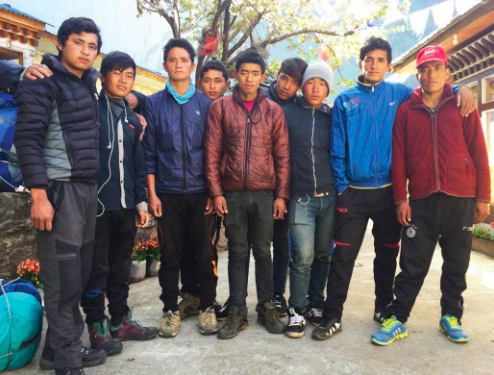
Amber reassured us. As relaxing as this first day was, it was still quite a shock for those of us who’d had no serious mountain walking. Even at a slow pace, four hours was intense. What a relief to arrive at Phakding! We started to feel our bodies and we knew we would have to go steadily and not rush. On the morning of our second day, we recited some prayers, made offerings, and set our motivation for the day. Although we were still a little sore, the cosiness of the dining room at breakfast and our shared determination lifted our enthusiasm. Amber had chosen his fellow Tamang people for our five guides and 11 porters. They were amazing! The porters carried three or four people’s bags on their bags, some carried 60 kilos. But Amber explained reassuringly to us that “carrying heavy loads is part of our culture. It’s not like something torturous, as you might think”. We were all moved by their resilience. And their faith. Ven Robina noticed that as they walked up the mountains, their heads bent low, seemingly seeing nothing but their feet, they were holding Rinpoche’s mala, which they wore around their necks.
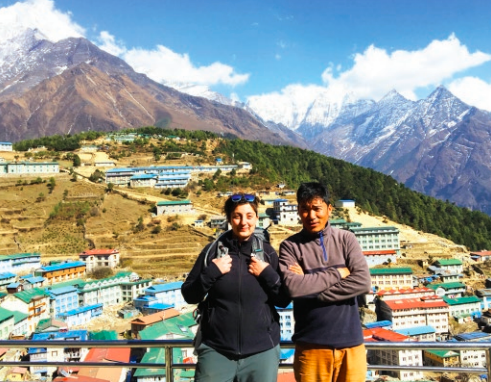
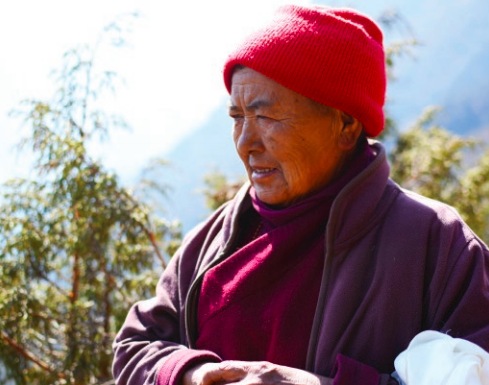
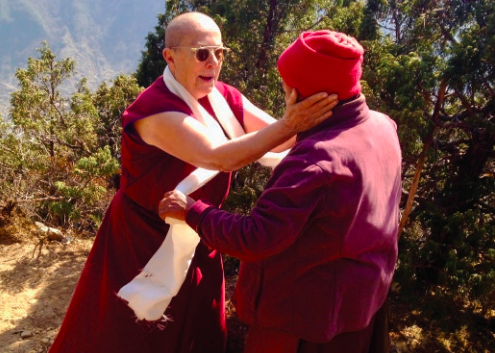
When we reached Lawudo
I couldn’t stop my tears. It was like coming home
— Sandra
We just naturally fell into several groups, each according to our pace, with Amber and the five guides taking incredible care of us, going back and forth, checking on every one of us. Throughout our trek, we meditated on Buddha Tara for strength, inspiration and guidance. We made offerings and invoked her energy as we walked, and often stopped to make offerings. The track was lined with stupas, mani stones and prayer flags to encourage us. And, as Kim noted, “It feels like the mountains are hugging us with the spiritual energy.” We’d planned on seven hours of walking on the second day, Phakding to Monjo, then on to Namche. But by lunch time in Monjo most of us were exhausted! No way could we imagine another four hours of walking. Some people were happy to continue, but everyone agreed to continue walking the next day. We didn’t rush, stopping regularly to catch our breath. On the last set of stairs into Namche, we really knew we were in the mountains: breathing was so difficult in the thin air, and every step upwards was intense. We surprised our guides and ourselves that all thirty-two of us managed to reach our lodge at Namche, Zamling Guest House. “I was filled with determination to keep going because of the encouragement of our guides and the group walking with me,” said Yas. “I would never have made it without them!” We met for a meal and a teaching in the evening. The owner kindly offered us his beautiful meditation room. Like so many devoted Tibetans and Sherpas, he had commissioned artists to cover the walls and ceilings in holy images. “It’s taken me ten years to make it like this,” he told us. In the morning, six of the group were experiencing altitude sickness, so one of the guides, Kancha, decided to stay with them. The rest of us kept moving upwards! This last leg was the most intense for many of us. “My muscles and feet felt fine,” Ven Robina said. “But I thought my lungs and heart would burst out of my body!”
Rinpoche’s sister Ani Samten-la, who’s run the place for nearly fifty years, walked down the hill to greet us, welcoming Ven Robina with a kata. It was so moving seeing these women meet for the first time. They seemed like two old friends who had been apart for a long time. And there was also the emotion from the overwhelming sense of physical achievement, having finally made it to Lawudo. We walked the last ten minutes to the front gate with a happy mind. “When we reached Lawudo I couldn’t stop my tears”, Sandra said. It felt like coming home. It was like I felt the presence of the yogis who spent so many years here meditating and blessing the place”.
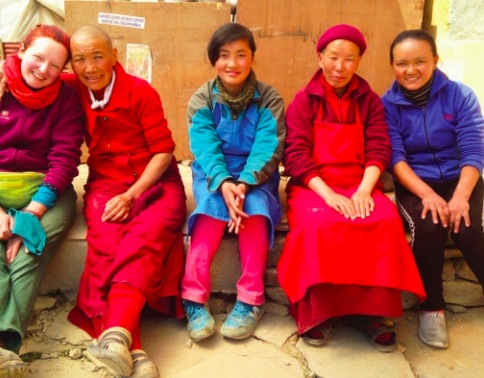

According to Ven Jamyang Wangmo, the author of The Lawudo Lama (Wisdom Publications), the place “is a beacon for all who seek an authentic, blessed and naturally mystical place”. Lawudo was built around a cave where Lama Kunsang Yeshe, known as the Lawudo Lama, meditated in the 1930s and 1940s. Ven Jamyang Wangmo writes that “Guru Rinpoche concealed texts and precious objects as treasures in certain remote and inaccessible valleys and sealed them with a very subtle mental barrier, transforming them into places of refuge for the people of future generations”. Lama Zopa Rinpoche returned to Lawudo for the first time since he was a boy in the spring of 1969, walking up from Kathmandu with his guru, Lama Yeshe, and other students. It has since remained a place for group and solitary retreat for students of the lamas. Rinpoche’s mother and Ani Samten-la together took care of Lawudo and the retreaters, and, since 1991 when her mother passed away, she has been supported by a local monk Ven Tsultrim Norbu. Our retreat was scheduled for five nights and six days. “You’re the biggest group we’ve ever had”, centre director Sangay-la, Rinpoche’s younger brother, told us. To accommodate us, he had built new rooms, set up an outdoor kitchen and mess tent, and brought in more help for Ani Samten-la including, Ani Ngawang, Ani Lobsang Drolkar, another cook, Jetha, his daughter Laxmi and Simone. We’d heard rumors about how Sherpas eat potatoes every day, but the food was amazing! Every day something delicious, something special. Everyone worked so hard to make us happy. We began our teachings and retreat in the gompa in the evening. We tucked ourselves into the wonderful, heavy woollen cloaks worn by Tibetan monks in their freezing gompas. We needed them: at night, it was sometimes minus 10 degrees celsius.
You don’t create merit unless you make effort
— Lama Zopa Rinpoche
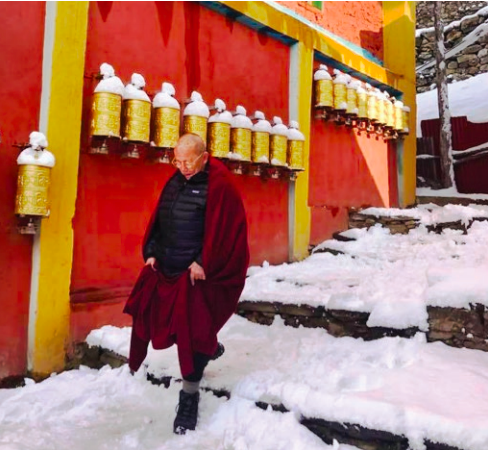
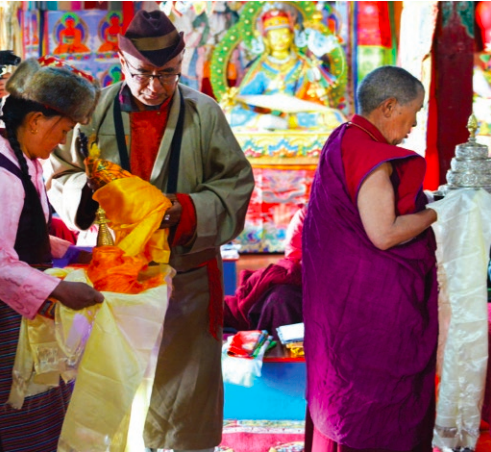
Happily, the next day, three of the women who’d stayed in Namche made it up the hill, and we heard that two of them went back to Kathmandu and one flew back to the United States. We all experienced plenty of physical and psychological discomfort, which is typical when people embark on a group effort in extreme and foreign environment. These challenges were met with compassionate teachings on suffering, enthusiastic perseverance, and impermanence – and in particular attachment. Ven Robina lovingly took time to remind us that this demonstrated the heart of our practice. “Our biggest problem in the West is our attachment to comfort. This is source of so much of our daily suffering. Attachment only wants the nice things; it cannot stand problems!” It was very clear that it is much easier to practice and listen to teachings with the convenience of comfort at our fingertips. On the other hand, Ven Robina told us, “As Rinpoche points out, ‘we only create merit when we make effort’.” For sure we are making effort! I’m sure Rinpoche must be pleased with us.” This was a powerful idea that seemed so simple yet we forget so often. Being reminded of we felt blessed to be there. We had an early morning meditation and several sessions of teachings throughout the day on various stages of the path to enlightenment. We were also lucky to hear some excerpts from Lama Yeshe’s book on mahamudra that Ven Robina was finishing editing for Wisdom Publications during the retreat. Our various motivations for joining the trek and diverse experience of the Dharma made for spirited and profound discussions. Ven Robina, through her amazing ability to connect with people and understand the essence of their questions, resounded strongly for all of us, in very different ways.
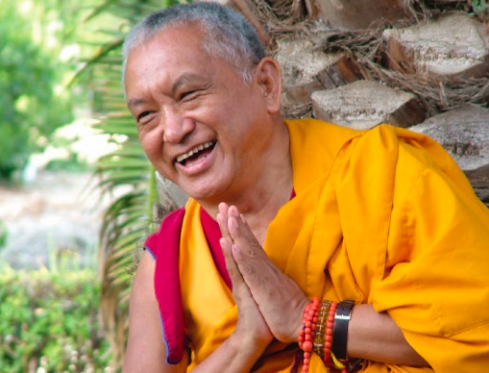
We gathered together to make offerings to Rinpoche’s cave on the second day. All of us managed to squeeze into the tiny space, essentially a hole in the rocks, to listen and pray. We then sat in the courtyard and recited The King of Prayers. Some of us also visited the stupa of the previous Lawudo Lama further up the hill, as well as the caves of other meditators at Charok. On April 15 we heard that Rinpoche was in retreat in Solu Khumbu, so Ven Robina emailed Ven Roger and asked for of word advice. Rinpoche very kindly replied:
“To my dear friends at Lawudo,
Thank you … billions of times, life is so short so what you are doing,
meditating on Lamrim, is the very best thing to do … way to use your life.
Samsara is the most suffering life – attachment to this life …
the big one on top of that is the ignorance grasping at a truly existent ‘I’!
I am sure you have done this retreat with good motivation
for the benefit of all sentient beings … the leaches, mosquitoes etc.
… for all of them… a billion thanks to Robina for organising that.
I am at Maratika where Guru Rinpoche
attained immortal life by achieving Amitayus.
With love and prayers,
Lama Zopa.”
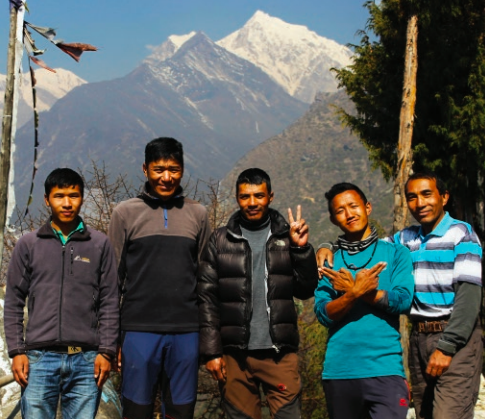
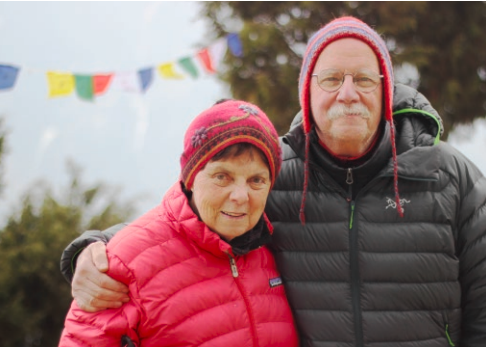
On our third day of retreat, Sangay-la announced, “Snow is coming!” This seemed like an odd comment, given the perfect sunny days and clear blue skies we’d had until then. “We need the water, so I’ve asked for snow”, he explained. Lawudo has no running water so it needs to be collected daily from a pump that runs along the side of the mountain and caught in tanks from rain and snow. Sure enough, that afternoon, clouds started to roll in across the valley and over Lawudo. As the cold change settled in overnight, Ven Robina hammered the same point as we huddled together in the gompa: attachment to comfort is our main problem. On the fifth morning, we woke up to a foot of snow outside our doors. The entire valley was covered white. As the sun rose over the mountain, it looked magical and it made our last day together seem all the more memorable.
Earlier in the week on our third day, Sangay-la informed us that it would be auspicious to offer long life prayers to the teacher at the end of the retreat. He said very clearly, “It is Dharma law!” Ven Robina was reluctant but finally agreed. “OK, but keep it simple.” It will be short, simple, but powerful, Sangay-la said, “Like a Dharma bomb!” At the tea break on the last day, Sangay-la, who was dressed in his best Tibetan chuba, Ani Samten-la and their helpers held a beautiful and auspicious ceremony. They offered traditional sweet rice and tea to everybody and we sang the long-life prayer written by Lama Zopa Rinpoche for Ven Robina. Sangay-la, Ani Samten-la and the others offered in procession a mandala and representations of the enlightened body, speech and mind – for the speech many volumes of the Fifth Dalai Lama’s teachings were offered. It was very moving. Ani Samten-la even went around to every single one of us, formally wishing us a long life. Somehow it all felt very natural, and we joked that we felt we’d been Sherpas or Tamangs before!
The Lawudo Trek was the best trip and experience of my life
— Amanda
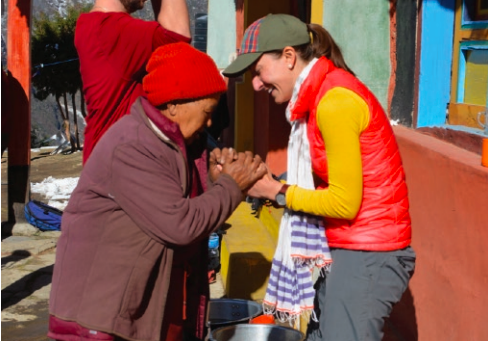
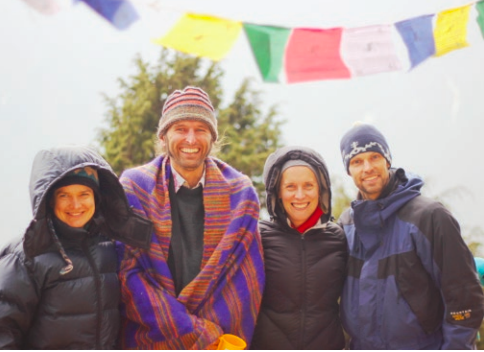
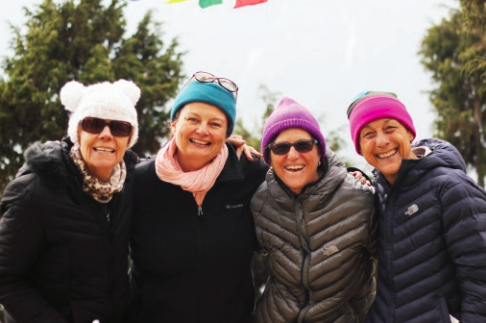
The snow had mostly melted by breakfast time. It was as though a path had been cleared for us to walk home after a purifying and invigorating retreat. After breakfast we presented Sangay-la with our offering of $8,000 for Lawudo. He said that it would be the first deposit in the newly created Lawudo Monastery bank account and that the funds would be used to buy water tanks, water transportation structures, materials for building, and additional accommodation. He said he was very pleased with how everything had unfolded and, for such a large group, he was delighted with “how harmonious everyone was”. He encouraged us to “Please come back soon!” We also made offerings to Ani Samten-la and all the staff. We could not have imagined such incredible care and kindness. Our return down the mountain was pretty uneventful. Half of us walked down to Lukla and for the other half Amber organised helicopters from the bottom of the hill. “I was delighted to spend another day at Lawudo – and equally delighted to give my legs a break”, Ven Robina joked.
We very nearly didn’t make it back to Kathmandu because of delays in the flights and the weather. With the intervention of our lodge owner, Dawa Sherpa, we just managed to get the last flight of the day. Our final two days in Kathmandu were spent in the utter luxury of the Hyatt! “You can find this anywhere in the world,” Raani told me at dinner that night. “But you can’t get the experience we just had at Lawudo anywhere else”. Gale said that the trek was “the best experience in my life to date.” And Nina felt that it was “special beyond words, and even more special that we got to share it” with everyone.
You came on a trek to Lawudo, a peaceful
and beautiful place for retreat.
This is the best kind of trek! It’s the most beneficial
— Sangay-la
Our planned final puja at Boudhanath Stupa moved indoors because of rain. Some of us took Refuge and the Lay Vows and Ven Robina offered everyone a small crystal stupa, reminding us of our enlightened potential. By this stage, we felt like family, sitting together in her room, overlooking the stupa. Lawudo is not easily forgotten. And we’d truly made the most of it. As Sangay-la said to us, “So many people come to Nepal to go trekking and never see or do anything related to Dharma. You came on a trek to Lawudo, a peaceful and beautiful place for retreat. This is the best kind of trek! It’s the most beneficial.”
Thank you Ven Robina, from the bottom my heart for your infinite kindness and patience. Thank you for working with me to make this experience exceed all expectations and be so special for so many people. Thank you for teaching me so much since we met and not giving up on me! Ven Robina and I were honoured to offer our services as volunteers to the lead and organise this trek. Thank you Sangay-la, Ani Samten-la and everyone at Lawudo for your incredible generosity and warmth. Thank you also to Amber and your team for your kindness in taking such good care of us during the entire trek. And a thousand thanks to you trekkers! It’s because of you that this first trek to Lawudo was so successful, auspicious and unforgettable.
With love and gratitude,
Kristina
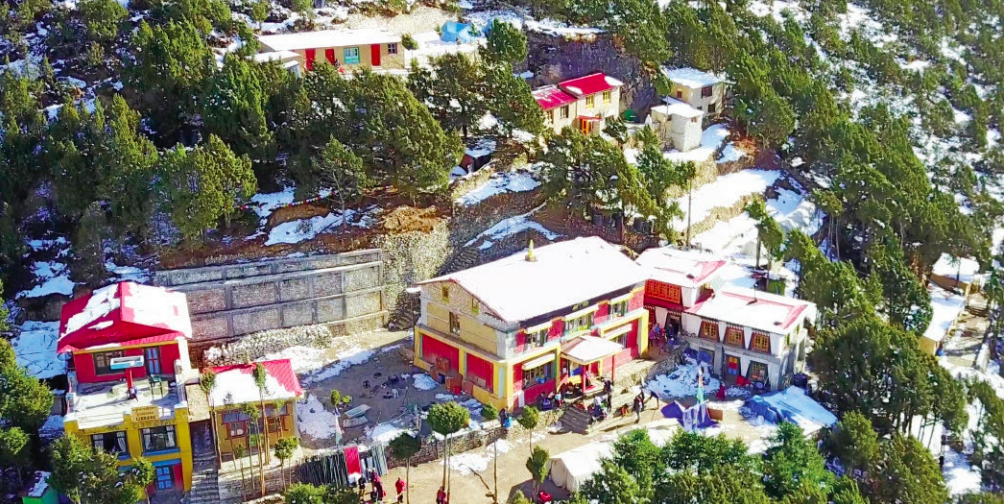
LAWUDO TREK IN NUMBERS
- US$16,000 raised for Lawudo
- 14,000ft climbed above sea level
- 500kg of luggage carried
- 32 trekkers
- 20 months of planning
- 15 days in Nepal
- 11 porters carried our things
- 9 staff with Ani Samten-la looked after us
- 7 nationalities represented
- 5 guides cared for us
- 1 retreat with Ven Robina
